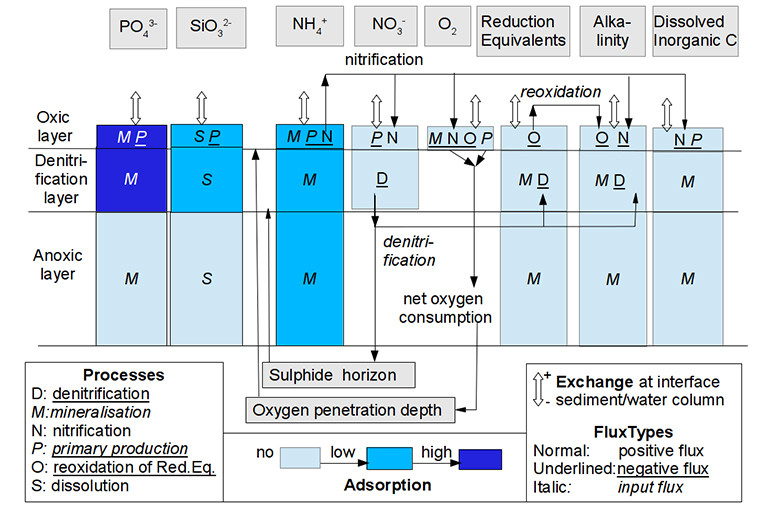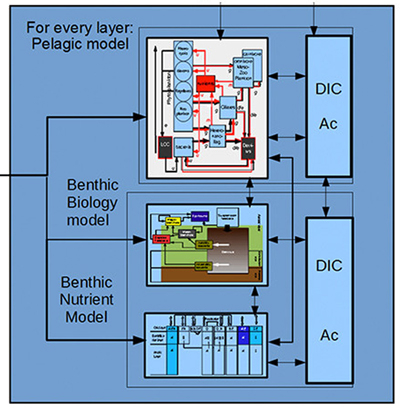Benthic nutrient model
The objective of the benthic nutrient-regeneration model is to quantify the nutrient fluxes across the sediment-water interface, the phase-transition processes such as denitrification and the buffer capacity of the sediment (Ruardij and Raaphorst, 1995). Relevant processes are diffusive vertical transport, adsorption/desorption and (bio-)chemical processes of constituents. Three distinct horizontal layers are distinguished. Thus, three (coupled) partial differential equations (one for each layer) have to be solved for each of the state variables. Based on the concentration in the overlying water, the production and/or consumption rates as a result of the (bio-)chemical processes (computed by the food web model) and the rates of adsorption/desorption these equations are solved. The effects of bioirrigation and bioturbation by the micro-, meio- and macro-benthos are included in the model.

Schematic overview of the benthic nutrient regeneration model. Ammonium is adsorbed in all three layers (blue, adsorbed:dissolved=3:1). Phosphate (dark blue, adsorbed : dissolved =200-400:1) and silicate (blue, adsorbed : dissolved =5-10:1) only in the oxic and denitrification (hypoxic) layer.
Constituents
Eight constituents are dynamically modelled : ammonium, nitrate, phosphate, silicate, dissolved inorganic carbon, alkalinity and reduction equivalents. The last one comprises all reduced constituents which originate from electron-acceptors other than O2 and NO3- , to wit Mg2+, Fe2+ and SO42-. We assume that organic matter is not an important electron acceptor in the anoxic part of the sediment; consequently the model cannot calculate methane formation.
The thickness of the three layers is dynamically modelled and varies with the process rates:
a high oxygen consumption rate leads to a reduction of the oxygen penetration depth and hence to a decrease in the thickness of the oxic layer. The thickness of the denitrification layer similarly varies with the denitrification rate.
For the computation of adsorption/desorption it is assumed that there is a fixed proportion between dissolved and adsorbed constituents. Only for ammonium, phosphate and silicate adsorption takes place. For ammonium the adsorption characteristics are the same in all the layers. For phosphate and silica the adsorption characteristics are different for the oxic layers (O2and NO3-layer) and the anoxic layer since phosphate and silicate mainly adsorb onto iron(III)-oxi-hydroxides and these are absent from the anaerobic layer. The iron-hydroxides are found on the surface of the silt particles and hence the proportion adsorbed:dissolved also depends on the percentage silt in the sediment.
The following processes are taken into account:
